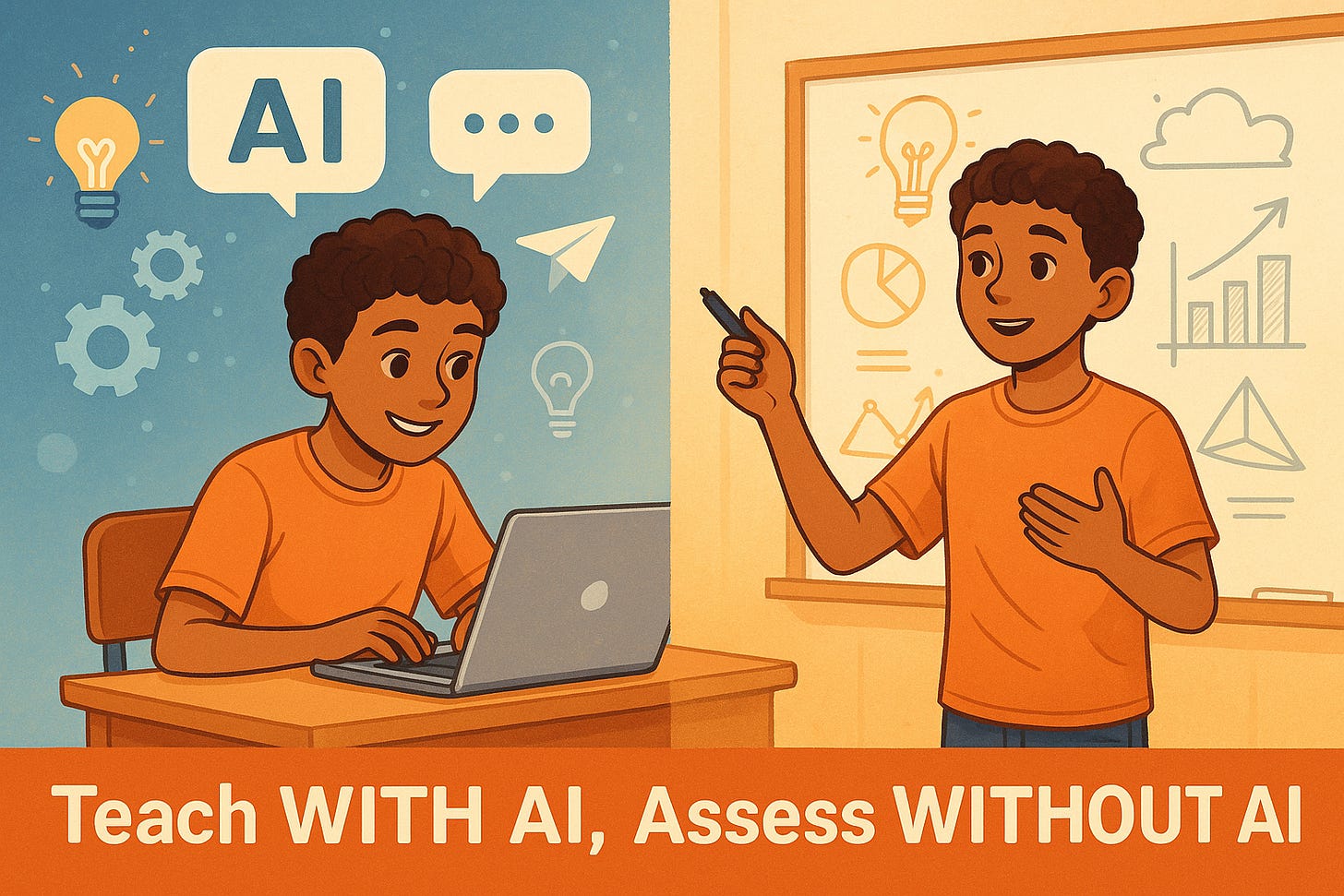Should Your 12-Year-Old Use ChatGPT for Homework?
How one heated dinner debate led to a simple framework that finally makes sense of AI in middle school
Where have I been for the last 7 weeks? Why the radio silence? Firstly, I took a break and travelled with family to India and Indonesia (much-deserved break). Secondly, I took up a new Product Leadership role at Iron Mountain Digital (a 2-year-old startup within Iron Mountain) to work on some exciting AI native initiatives—more details to follow. I promise an exciting flow of information from now on, starting with this article.
- Urvish.
Last week at a Product Led Alliance CPO Summit 2025 dinner in Boston, I brought a domestic argument to the table. (Bonus at the end)
Should middle schoolers use Generative AI in and out of the classroom?
I argued YES. My wife, who teaches middle school, argues NO. She wasn't there, but her voice was. I carried both sides to the room.
What followed was less a polite debate and more a stress test for how we want kids to learn right now. Everyone wanted the same thing: capable, resilient kids who can actually think. We just differed on the order of operations.
The Case for Early AI Exposure (FOR)
I made the case for exposure first. Kids will live in a world where AI is built into every tool they touch: Google Docs, email, design apps, their school's learning management system, and even their browser. Waiting until college to teach responsible AI use feels like waiting to teach driving until highway speeds. If they're going to work alongside AI for the rest of their lives, starting early builds fluency and judgment before the stakes get high.
To make it concrete, I pulled out a familiar story: remember Microsoft Excel? When spreadsheets landed in the workplace, every accountant feared the end of their profession. It wasn't the end. The job shifted. The best accountants used Excel to get past basic arithmetic and into analysis, risk assessment, and strategic advice. The profession didn't die; it leveled up.
The same thing happened with calculators. Remember the panic? Kids would never learn their times tables! They'd become mathematically helpless! What actually happened? Memorizing multiplication tables stopped being the finish line. Problem-solving took over. Tools moved the floor up, not the ceiling down.
This is the pattern. We adapt. We upskill. We don't just survive technological shifts; we use them to tackle bigger, more interesting problems.
The Case for Protecting Young Minds (AGAINST)
But I also carried my wife's voice into that room, and the educators at the table jumped right in. Middle school is where thinking habits are set in concrete. If a tool can draft their essays, solve their math problems, and explain scientific concepts, students might delegate the very cognitive work that builds reasoning skills.
Dependency is easy to teach and brutally hard to unwind. Pull the power for an hour—does everything stop? A developing brain needs what one parent at our table called "time under tension." Like strength training, cognition grows when it does the heavy lifting, not when a machine does it for you.
The concern isn't just philosophical. These educators see kids who panic when WiFi goes down. Kids who can't focus for five minutes without checking their phones. Are we about to create the same dependency, but with thinking itself?
The Question That Changed Everything
The conversation was getting heated until someone asked the right question:
"What must a student be able to do without AI, and what should they be able to do with AI?"
That reframing replaced ideology with design. It led us to a simple principle I'm comfortable standing behind:
Teach with AI,
Assess without AI.
"Teach with AI" refers to using AI to accelerate exploration and feedback. Have it generate contrasting thesis statements, surface counterexamples, propose alternative solution paths, explain code in plain English, or rewrite a paragraph in three different styles. Let students see options quickly, then decide.
"Assess without AI" means the proof of learning still lives in the student's head and hands. An oral defense. A whiteboard derivation. A short write-up on paper. A live explanation of trade-offs. If they can't explain it without the tool, they don't own it yet.
Once that principle landed, the anxiety in the room dropped. It's not all or nothing. It's about sequence and balance.
What This Actually Looks Like in Practice
Picture a history lesson. The student asks AI for three different thesis directions on the same historical event, chooses one, improves it, and writes a paragraph. Then the teacher picks two students to defend their thesis out loud for sixty seconds with no screens allowed. Did they learn? You can tell immediately.
Or take Science. Have AI produce two flawed hypotheses about an experiment. Students identify the flaws, correct them, and then sketch a test plan. A two-minute whiteboard check at the end shows who actually understood cause and effect versus who just copied and pasted.
English class? Feed a paragraph to AI and ask for three rewrites: concise, persuasive, descriptive. The student takes the best parts from each, adds their own voice, and writes a one-line rationale for each change. That trains editorial judgment, not copy-and-paste skills.
Math? Solve the problem on paper first. Then ask AI for a different method. Compare the two approaches and defend which is more efficient and when. The tool accelerates understanding, but the student still has to think.
Computer science? Ask AI to explain a function, then write your own comments and documentation, and discuss one "what if" scenario for how you'd modify it. The AI gives you the foundation; you build the understanding.
Making It Work at Home
The same approach works outside the classroom. Before your child opens ChatGPT, ask one simple question: "What are you trying to accomplish in the next twenty minutes?" After they're done, ask another: "What did you change and why?"
If they can answer cleanly, the tool stays in its proper supporting role. If they can't, try tapering back the AI assistance next time and add a short no-tech block, such as a page of outlining by hand, a handwritten summary, or a few problems worked out on paper.
Kids build confidence fast when they discover they can do it both ways.
The Stories That Stuck
Three scenarios emerged that crystallized the practical challenges we're all facing.
The first was about fluency versus understanding. What happens when a student can generate ideas quickly with AI assistance but struggles to articulate those same concepts verbally? The solution we discussed was simple: end every AI-assisted work session with a brief "explain it back" moment without any digital tools. This creates a natural check for whether the learning actually stuck.
The second challenge was about authentic assessment. How do teachers evaluate student work when they can't distinguish between human effort and AI output? The approach that emerged was transparency through process documentation. Having students submit their prompts alongside their final work, plus showing their revision history, transforms the grading experience. Teachers can respond to the student's actual decision-making rather than just the polished result.
The third dilemma centered on scaffolding versus dependency. When AI clearly improves a student's output quality, how do you know if you're helping or hindering their development? We reframed this as diagnostic rather than problematic. Strong AI-assisted performance becomes the target. The goal is to use the tool to reveal what good work looks like, then gradually reduce assistance until the student can match that quality independently.
The Practical Details Matter
Will some students misuse these tools? Absolutely. They already misuse older tools like Google and Wikipedia. The answer isn't to ban everything. It's to tighten the assessments. A short oral defense changes incentives because bluffing becomes obvious in real-time.
Worried about time? Start small. Add a two-minute verbal check to one assignment per week. Require prompt logs for transparency. Include a weekly "paper and pencil" block. You don't need to overhaul your entire curriculum to restore an authentic signal about student understanding.
For different grade levels, we sketched out a progression.
Sixth grade: prompts, summaries, vocabulary help, concept checks, and example generation. Always test understanding offline.
Seventh grade adds critique and revision skills.
Eighth grade can handle synthesizing multiple sources, tracking bias, and project planning—all with full disclosure of AI assistance.
A Policy That Actually Works
If you want a clear policy to share with your school or family, here's what our table landed on:
You can use AI for ideas, structure, and examples.
You must disclose how you used it.
You must edit the output and explain your changes.
You must be able to defend the work without help.
You cannot submit AI-written final answers for graded work.
It's clear, enforceable, and respects both progress and rigor.
The Reality Check
A quick self-check helps keep everything honest: Can you explain this work out loud right now? What did AI add, and what did you add? What breaks if the power goes out? Could you cut anything and still preserve the core meaning?
If those answers hold up, your balance is probably right.
Where We Landed
I walked into that dinner arguing hard for AI in classrooms. I walked out still supporting it, but much more precise about when and how. Early exposure, but with strong guardrails. Teaching methods that utilize AI to expand examples and accelerate feedback loops. Assessments that prove students can think without digital assistance. Disclosure as a non-negotiable habit. Regular "time under tension" to build cognitive stamina.
My wife's purist stance didn't lose the argument. It shaped the rules. That's the outcome I want for classrooms and homes: a thoughtful design that keeps foundational skills strong while preparing kids for the world they'll actually inherit.
The room moved toward the middle, but with a spine. We're not choosing between innovation and tradition anymore. We're designing a system that honors both.
If you're deciding what to do for your child or your classroom, start with that principle: teach with AI, assess without it. Make explanation, effort, and honesty non-negotiable. Then watch students develop fluency in both independent thinking and collaborative tools.
That's not a compromise. That's coherence. And it's precisely what this moment demands.
-keep AIing, Urvish
Bonus - A quick pic from CPO Summit 2025 Boston Dinner at SRV, Boston, MA where the debate went down :)
Pic Courtesy: Denise Cheung



